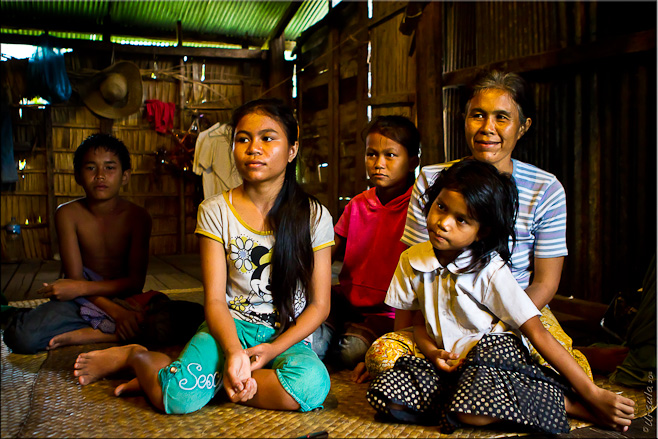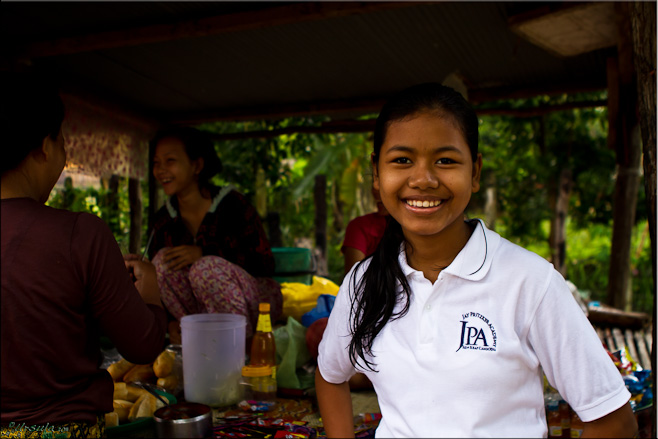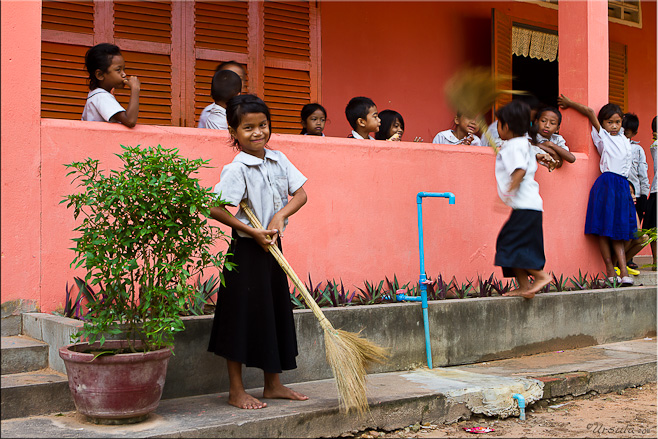There is something special about being a “visitor” instead of a “tourist” when you are travelling: getting a glimpse into the real, everyday lives of ordinary people, rather than the “show homes” set up by tour operators.

Portrait: A Rural Khmer Family, Proyyut Village, Cambodia
Let me introduce you to an “average” rural Khmer family: Mum and her four children.
I met Sony, the eldest of the four siblings, the first morning I visited Sandan School. She’s a bright girl, and was lucky enough to be chosen to attend the Jay Pritzker Academy (JPA), an American school which provides free schooling, uniforms and materials to about 365 students in the local area.

Fourteen-year old Sony is a student at JPA.
Sony is delightfully self-possessed and easy to talk to. Her schooling may account for some of this: JPA’s vision is to be “the best school in Cambodia and competitive with the best schools worldwide” while keeping students integrated with their local communities and cultural values. Her English is excellent, and we were able to chat about a range of topics: from health, education, and social issues in Cambodia, to the country’s history, and her personal plans for the future.
I later discovered that Sony’s youngest sister, Nana (age 5), was one of the students I had focussed on in the Sandan School first grade classroom.

Nana Sweeping

Nana and her classmates at their first-grade classroom window.

Nana in the Classroom
As part of the photo-tour I was participating in (under the guidance of Karl Grobl, Marco Ryan, Gavin Gough and Matt Brandon), I was expected to create a photographic essay with another group participant. We wanted to focus on one student: at home and at school. Having Sony as our guide and liaison made this possible, and we arranged to visit Nana and Sony at their home in a neighbouring village.
It was raining the first afternoon we went to visit. When we turned off the last bit of asphalt and onto a slippery red dirt road with potholes big enough to swallow our tuk-tuk, our driver showed serious reluctance about continuing. Sony had given him directions, but we still had to stop several times to ask for directions. There were no signposts and the lots were not numbered.
The family lives in a bamboo house on stilts, next door to a similar house on the same farming allotment, belonging to a member of their extended family. I was grateful I was wearing plastic shoes: there was no “driveway” – the houses are reached by picking your way over the least-wet patches of ground.

Sony and Nana's home in Proyyut Village, Cambodia.

Corrugated iron house on stilts: no windows, ladder entry

Rusty corrugated-iron house siding.

Auntie next door, with her baskets. The red marks on her forehead are from hot-cupping, a local remedy for headache and other ailments.
The families grow rice for their own consumption. As Sony said: if they sold it, they would not have enough for next season’s planting. Auntie owns the land. She makes baskets which she sells at the local market for 100 reils (KHR) each: about two cents American. Sony and Nana’s mother also weaves baskets when she has finished tending the rice and other crops. She has been widowed for three years now: Sony and Nana’s father died of stomach problems in 2008, leaving mum to manage on her own. Sony still finds it hard to talk about him, but showed me the shrine with his picture in it in a corner of the “living room”.

Mum at Home

Gran lives close by. She came over to get a look at the strangers.

Nana and her sister at home: a hammock under the house.
Nana’s middle sister Srai Ranoch is in grade four at Sandan School. Her class attends in the afternoons, while Nana’s is in the morning, so they are not actually in school at the same time. They are fortunate to have Sony at JPA because it relieves some of the financial pressure on the family. Even though schooling is free, each child is expected to contribute towards tests and materials. While this contribution is small, it represents a huge proportion of the meagre family income. Their brother, who is thirteen, dropped out of school three years ago to help Mum with the fields. Sometimes he is able to earn a little money helping the neighbours.

Nana and her brother

Cousins: Foreign visitors are uncommon in this little village, so the cousins next door have come over for a look.

Nana dancing with her dog.
The second time we went to visit, the sun came out, and with it came even more of the neighbouring children. They all led us on a wonderful excursion through the rice patties and fields that comprise their back yard.

Cousin up a Tree

Getting fresh coconut for the visitors.

Afternoon rainbow in the rice fields.

Blue Toad

Summer Rice

Worker tilling the rice fields

Girl in a rice field

Bringing in the cows.

Time for a chat: Sony, Nana and their cousin take time out.

End of the day: afternoon on the rice patties.
 We were grateful to Sony and her family for letting us visit, and giving us an insight into their lives.
We were grateful to Sony and her family for letting us visit, and giving us an insight into their lives.
I hope they both continue to study hard and build a better future for themselves and their family.




























.png)


Lovely, Ursula! Wonderful story and images!
These lovely people seem so lovely and have so little… bless them and their generosity and wonderful smiles.
Hi Lisa and Signe!
These people have such sadness in their pasts and difficulty in their presents, but they still make it so easy to make pictures around them. It was a joy to visit them. 🙂
love all these photos so much 🙂
Thanks, Anthea! The people make it easy ~ the dark houses make lighting a nightmare. 😉
I love all the people and picture .it great and wonderful .
Thanks, Sanan!
It’s great to have your company for the trip. 🙂
A very moving testimony of the reality of life Cambodge.Chaque family has its own story more or less happy, but this country has a very difficult to forgive recent history.
But Cambodians are very intelligent and hardworking people.
Thank you for this story that I for one am also on FLICKR.
Thanks for your visit, Georges. It is true: there is still a real sadness in the country. But the people are wonderful – I love visiting.